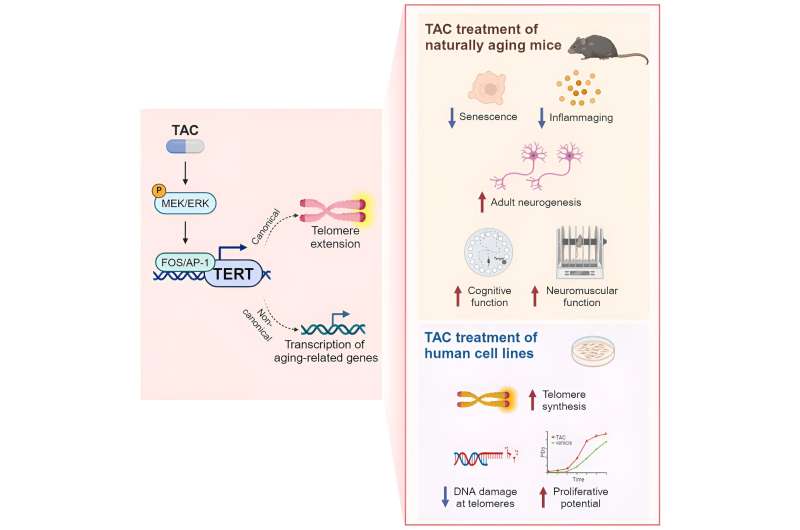This article has been reviewed according to Science X's editorial process and policies. Editors have highlighted the following attributes while ensuring the content's credibility:
fact-checked
peer-reviewed publication
trusted source
proofread
Activating a molecular target reverses multiple hallmarks of aging, new study demonstrates

Researchers at The University of Texas MD Anderson Cancer Center have demonstrated that therapeutically restoring "youthful" levels of a specific subunit of the telomerase enzyme can significantly reduce the signs and symptoms of aging in preclinical models. If these findings are confirmed in clinical studies, there may be therapeutic implications for age-related diseases such as Alzheimer's, Parkinson's, heart disease and cancer.
The study, published today in Cell, identified a small molecule compound that restores physiological levels of telomerase reverse transcriptase (TERT), which normally is repressed with the onset of aging. Maintenance of TERT levels in aged lab models reduced cellular senescence and tissue inflammation, spurred new neuron formation with improved memory, and enhanced neuromuscular function, which increased strength and coordination.
The researchers show that TERT functions not only to extend telomeres, but also acts as a transcription factor to affect the expression of many genes directing neurogenesis, learning and memory, cellular senescence, and inflammation.
"Epigenetic repression of TERT plays a major role in the cellular decline seen at the onset of aging by regulating genes involved in learning, memory, muscle performance and inflammation," said corresponding author Ronald DePinho, M.D., professor of Cancer Biology.
"By pharmacologically restoring youthful TERT levels, we reprogrammed expression of those genes, resulting in improved cognition and muscle performance while eliminating hallmarks linked to many age-related diseases."
Loss of TERT is connected with aging through multiple mechanisms
Aging is associated with various epigenetic changes that influence functional and physiological decline. One of the hallmarks of aging is the gradual shortening of telomeres, the chromosomal end structures that help maintain their stability. Free radicals also can modify and harm telomere sequences.
When telomeres become extremely short or modified, they trigger a continual DNA damage response, which can lead to cell senescence—a phenomenon in which cells release inflammatory factors that can cause tissue damage, prompting aging and cancer.
Telomerase is a protein complex responsible for synthesizing and extending telomeres. However, its activity is reduced over time due to the epigenetic silencing of TERT, particularly at the onset of natural aging or Alzheimer's and other age-related diseases.
The DePinho laboratory previously showed that deactivating the TERT gene in vivo led to premature aging, which could be reversed through TERT reactivation. The researchers also observed that certain cells, such as neurons and cardiac cells, were rejuvenated without undergoing the normal cell division required to synthesize telomeres.
Their observations led them to hypothesize that TERT had other functions beyond synthesizing telomeres and that overall telomerase levels were important in the aging process. Based on these findings, the researchers, led by DePinho and first author Hong Seok Shim, Ph.D., aimed to develop a drug to restore TERT levels.
Small molecule restores TERT levels, reversing hallmarks of aging
A high-throughput screen of over 650,000 compounds identified a small-molecule TERT activating compound (TAC) that epigenetically de-represses the TERT gene and restores physiological expression present in young cells.
In preclinical models equivalent to adults over age 75, TAC treatment for six months led to new neuron formation in the hippocampus (memory center) and improved performance in cognitive tests. Additionally, there was an increase in genes involved in learning, memory and synaptic biology, consistent with TERT's ability to interact with and control the activity of transcription factor complexes regulating diverse genes.
TAC treatment also significantly reduced inflammaging—an age-related increase in inflammatory markers linked with multiple diseases—in both blood and tissue samples and also eliminated senescent cells by repressing the p16 gene, a key senescence factor.
TAC improved neuromuscular function, coordination, grip strength and speed in these models, reversing sarcopenia—a condition under which muscle mass, strength and performance naturally worsen with advancing age.
Additionally, TAC treatment in human cell lines increased telomere synthesis with reduced DNA damage signal at telomeres and extended the proliferative potential of these cells, demonstrating the activity of TAC in ex vivo human models.
"These preclinical results are encouraging, as TAC is easily absorbed by all tissues, including the central nervous system. Yet further studies are needed to properly assess its safety and activity in long-term treatment strategies," DePinho said. "However, our deeper understanding of the molecular mechanisms driving the aging process has uncovered viable drug targets, allowing us to explore opportunities to intercept the causes of a variety of major age-related chronic diseases."
More information: Hong Seok Shim et al, TERT activation targets DNA methylation and multiple aging hallmarks, Cell (2024). DOI: 10.1016/j.cell.2024.05.048.


















